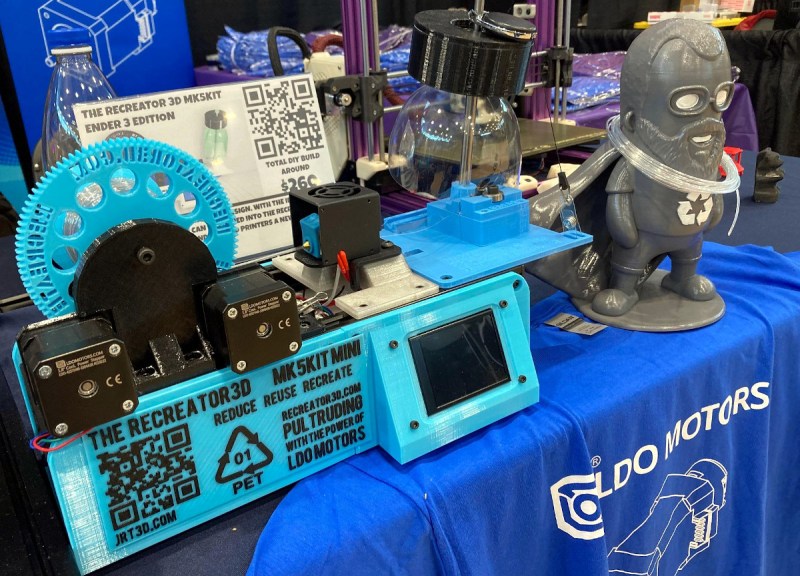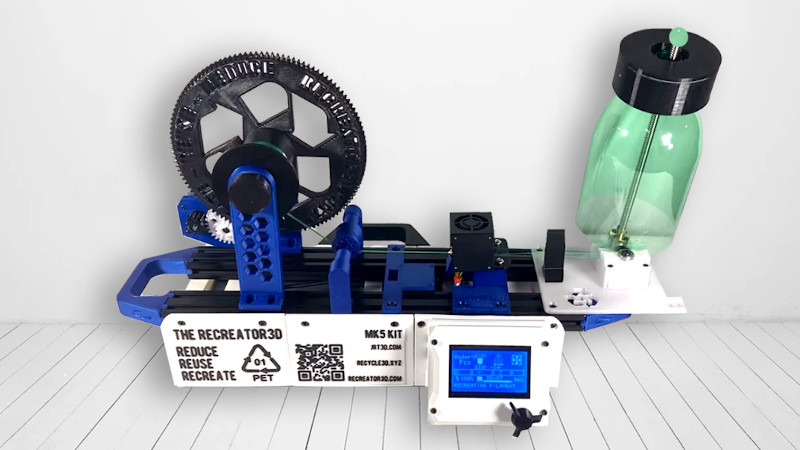In Back to the Future, Doc Brown returns to 1985 with a version of his DeLorean time machine that has been modified with technology from the future. After telling Marty they need to go on yet another adventure, Doc recharges the DeLorean’s flux capacitor and time circuits by tossing pieces of garbage into the slick Mr. Fusion unit mounted to the rear of the vehicle. The joke being that, in the future, you could simply head over to the local big box store and pick up a kitchen appliance that’s capable of converting waste matter into energy.
Unfortunately, we’re nowhere near powering our homes with banana peels and beer cans. But if the Recreator 3D is any indication, the technology required to turn plastic bottles rescued from the trash into viable PET filament for your 3D printer is all but upon us. While there are still some aspects of the process that could stand to be streamlined, such as fusing multiple runs of filament together into one continuous roll, the core concepts all seem to be in place.

Creator [Josh Taylor] made the trip out to the 2022 East Coast RepRap Festival to not only show off the Recreator 3D, a project he’s been working on now for over a year, but to get people excited about the idea of turning waste plastic into filament. It’s not necessarily a new concept, and in fact [Josh] says earlier efforts such as the PETBOT are what inspired him to create his own open source take on the “pultrusion” concept.
According to [Josh], actually printing with the recycled filament isn’t that different from using commercial PETG, though it’s recommended you lower your speeds. A nozzle temperature of around 260 °C seems to work best, with the bed at 70 °C. Interestingly, the filament produced by the process is actually hollow inside, so the most critical change to make is increasing your extrusion rate to about 130% of normal to compensate for the internal void.
The current revision of the Recreator 3D, known as the MK5Kit, can be assembled using several core components salvaged from a low-cost Ender 3 printer in addition to a number of parts that the user will need to print themselves. For those who’d rather not source the parts, [Josh] says he hopes to get formal kits put together sometime next year, thanks to a partnership with LDO Motors.
But ultimately, [Josh] says the most important thing to him is that the plastic is recycled instead of getting sent to a landfill or incinerator. So whether you build a Recreator 3D or come up with your own design, all are welcome to the PET Pultruders United Facebook group he’s created to discuss the finer points of turning plastic trash into treasure.
















I actually really wanted to build one of these but didn’t want to go through the hassle (and cost) of buying a whole Ender 3. It felt overkill to me to run an entire Marlin system when I had all the parts laying around my desk. The result was a busy few days searching out a simple menu system for the Arduino and what I’m calling the petinator firmware for now. Mostly just a personal project, but if Josh wanted to use it to avoid buying expensive Marlin-capable boards and instead focus on little things like the Arduino nano (I got mine at $2 a piece) or ESP32 for a fancy wifi “notify me when my filament is ready” system, I’d be happy to make code edits or accept pull requests.
Link: https://github.com/aamott/petinator
Very nice, thank you.
I’m working on something very similar for the Polyformer where im getting a EBB42 board working as a minimal pulltrusion control board (only ~$10-15) without needing marlin and a SD card for control. If you have the time, it would be great to see you on the Polyformer discord
Aamott – please reach out to me so we can talk more about your project. I love the idea. Would love to see thermal runaway implemented as that is one of my main draws to using a 3D Printer controller. Yours is good for simplicity and general need. I love the expandability though that a 3D Printer board can allow someone’s ideas further.
Joshua Taylor – I’m working on the Polyformer pulltrusion device, and also think that collaboration would be really beneficial to advancing the ease of use for Pet to Filament machines. The expandability is also something I believe is beneficial to the projects. By any chance are you on Discord? it would be great to discuss this kind of project with you
Alextrical : Discord group – https://discord.gg/c8R4rjszbY
Welcome – and open to discussion.
Lately I started to build similar project, still waiting for the rest of the parts, but in general seems to be working good, we will see…
https://cults3d.com/en/3d-model/tool/pet-machine-make-your-own-filament-from-plastic-bottles-at-home-tylman_design-2
Destroy an Ender 3 to make this? Really?
Most have a spare or dead ender 3, and used / unrefurbished printers can be found cheap on ebay for cost of parts…for people who don’t want to “destroy” a good printer – we offer The Recreator 3D : ADD-ON
https://youtu.be/LPCBbaoczBw
Don’t have an ender to sacrifice, but I’d be willing to abuse a MPSM…
It seems like you don’t NEED an Ender necessarily, it’s just that all the parts you do need can be salvaged from one. But could just as easily source your own extrusion, hotend, stepper, etc.
Or just upgrade your ender 3 and repurpose the old parts you remove ,the ender 3 could use upgrading of those parts anyways especially if you want to print with PETG or makeshift filament equivalent
This project was made specifically because there are lots of returned/surplus ender3’s on eBay that are contributing to e-waste.
Really like this design, and tempted to put one of my own together, but the thing that always stops me is how cheap filament is these days…
I’m way better at turning filament into trash though
PET bottles aren’t a homogeneous material. There’s an inner layer of virgin PET. The outer layer making up the bulk of the bottle is recycled PET. In between there can be oxygen barrier layers, layers to block UV light, and other types of material.
The layers start out thick in the preform, which looks like a thick walled test tube with the collar ring and threaded neck. The preform gets clamped into a heated mold then hot air or gas (most likely nitrogen) is blown inside to stretch the bottle out to fill the mold. A quick shot of cold air or gas solidifies the bottle without cooling the mold much. Pop the mold open, bottle falls out, mold goes back around to restart the cycle.
Cutting a spiral strip out of PET bottles then forming it into filament will stretch out the layers even more. Squeezing it yet again through a sub-millimeter hole should still result in output with the layer materials strung out side by side.
Yet somehow there are tons of videos of people printing stuff with it just fine :)
What about recycling failed or otherwise incorrect PLA prints? Shredding them would be easy enough, is the chemistry wrong for it to be viable?
It’s certainly possible to do, but the issue is with the amount and precision of processing you have to do with it. First, you couldn’t just throw random components in a hopper; there would be uneven heating and tons of air pockets, so it would be better to grind it up somehow, but that would require an extra bit of processing. Second, PLA will burn or start to smoke if you don’t do it right. This part, I would take with a grain of salt, just because I’ve only tested this with a soldering iron that probably had other stuff on it, but you would still need a fair bit of experimentation to figure it out. The largest problem is still probably the pre-processing, but I dunno, maybe that could be part of the production line a PLA pulltruder would have.
Looks like you can get rid of the hollow with a little patience https://www.thingiverse.com/thing:5435208
How many bottles does he need to convert to break even on the material? There seems to be a whole lot of printed plastic in this build!
I don’t quite understand how he can pull the bottle through the cutter when there is a melted section right after the nozzle. Also, when the spool starts to fill up, the diameter increases, but it is quite difficult to properly account for that in software, since you don’t know exactly how the filament is on the spool. How does that work? Does it simply change the speed a little without impacting the final result too much?
It’s not being fully melted. It’s at a temp that make it pliable enough to be stretched and reformed.
Guys you really dont want to be heating that styrene and neoprene compound plastic. That shits toxic!
Guy, you really don’t want to be hassling people about what they choose to melt on the internet. That shits toxic!
This type of solutions only work in the parts of the world that don’t recycle their pet-cans. In Scandinavia, we pay an extra fee when we purchase the drink that we get back when we recycle it, An effective implicit incitament that makes people recycle the cans to new cans, to make other things with cans made out of PET is therefore worse but it depends on wherever filament you were to buy if you did not recycle your cans to filament. Interesting solution and great to avoid the plastic to go in the ocean or landfill but is there a life cycle analysis with the plastic after you use it? How to you recycle it then? And where to the plastic go when you are thru with it?
Here in the US we only get $0.05 back on a Carbonated Drink Bottle. So – there is a TON of plastic that doesn’t have financial incentive. Otherwise it ends up in our bi monthly Recycling pickup and seen as “waste” – so, now with Recreator3D and other PET Pultrusion units, we can reclaim this waste into a viable filament for our 3D printing needs, rather then buy new plastic – among raising oil cost, new plastics will cost more money.
HEY GUYS, IM BUILDING THE MACHINE NOW AND NEED TO KNOW WHERE TO GET THE SD CARD INFORMATION OR IS IT AN OPTION ON THE DISPLAY SCREEN? CONCERNED ON HOW TO SET THE STEPPER MOTOR SPEEDS. THANKS RENO
PS, SORRY FOR THE CAPS BUT EASIER FOR ME TO SEE.
We should soon be able to make a small cube quite simply….an entry in section and exit in filament…if we can implement the new improvements as in parallel circuit or which is added (colorings see mix, it will be just at the TOP)…Some competitions can help I think…Courage